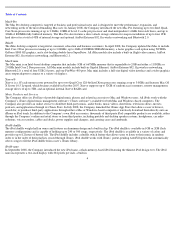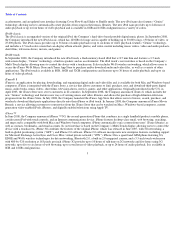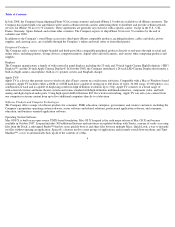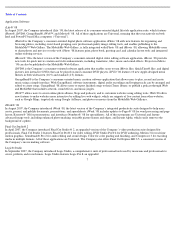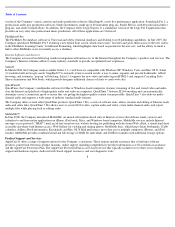Apple 2008 Annual Report Download - page 17
Download and view the complete annual report
Please find page 17 of the 2008 Apple annual report below. You can navigate through the pages in the report by either clicking on the pages listed below, or by using the keyword search tool below to find specific information within the annual report.
Table of Contents
Robert Mansfield , Senior Vice President of Hardware Engineering, joined the Company in November 1999 as Vice President of Development
Engineering and assumed his current position in May 2008. Prior to joining the Company, Mr. Mansfield was Vice President of Engineering at
Raycer Graphics and a Senior Director at Silicon Graphics, Inc.
Peter Oppenheimer, Senior Vice President and Chief Financial Officer, joined the Company in July 1996. Mr. Oppenheimer also served the
Company as Vice President and Corporate Controller and as Senior Director of Finance for the Americas. Prior to joining the Company,
Mr. Oppenheimer was Chief Financial Officer of one of the four business units for Automatic Data Processing, Inc. (“ADP ” ). Prior to joining
ADP, Mr. Oppenheimer spent six years in the Information Technology Consulting Practice with Coopers and Lybrand.
Philip W. Schiller, Senior Vice President, Worldwide Product Marketing, rejoined the Company in 1997. Prior to rejoining the Company,
Mr. Schiller was Vice President of Product Marketing at Macromedia, Inc. from December 1995 to March 1997 and Director of Product
Marketing at FirePower Systems, Inc. from 1993 to December 1995. Prior to that, Mr. Schiller spent six years at the Company in various
marketing positions.
Bertrand Serlet, Senior Vice President, Software Engineering, joined the Company in February 1997 upon the Company’
s acquisition of NeXT
and also served the Company as Vice President of Platform Technology. At NeXT, Mr. Serlet held several engineering and managerial positions,
including Director of Web Engineering. Prior to NeXT, Mr. Serlet worked as a research engineer at Xerox PARC from 1985 to 1989.
Sina Tamaddon, Senior Vice President, Applications, joined the Company in September 1997. Mr. Tamaddon has also served with the
Company as Senior Vice President, Worldwide Service and Support, and Vice President and General Manager, Newton Group. Before joining
the Company, Mr. Tamaddon held the position of Vice President, Europe with NeXT from September 1996 through March 1997. From
August 1994 to August 1996, Mr. Tamaddon was Vice President, Professional Services with NeXT.
Item 1A. Risk Factors
Because of the following factors, as well as other factors affecting the Company’s financial condition and operating results, past financial
performance should not be considered to be a reliable indicator of future performance, and investors should not use historical trends to anticipate
results or trends in future periods.
Economic conditions could materially adversely affect the Company.
The Company’s operations and performance depend significantly on worldwide economic conditions. Uncertainty about current global
economic conditions poses a risk as consumers and businesses may postpone spending in response to tighter credit, negative financial news
and/or declines in income or asset values, which could have a material negative effect on the demand for the Company’s products and services.
Demand could also differ materially from the Company’s expectations since the Company generally raises prices on goods and services sold
outside the U.S. to offset the effect of the strengthening of the U.S. dollar, a trend which has been very pronounced recently. Other factors that
could influence demand include continuing increases in fuel and other energy costs, conditions in the residential real estate and mortgage
markets, labor and healthcare costs, access to credit, consumer confidence, and other macroeconomic factors affecting consumer spending
behavior. These and other economic factors could have a material adverse effect on demand for the Company’s products and services and on the
Company’s financial condition and operating results.
The current financial turmoil affecting the banking system and financial markets and the possibility that financial institutions may consolidate or
go out of business have resulted in a tightening in the credit markets, a low level of liquidity in many financial markets, and extreme volatility in
fixed income, credit, currency and equity markets. There could be a number of follow-on effects from the credit crisis on the Company’s
business, including insolvency of key suppliers resulting in product delays; inability of customers, including channel partners, to obtain credit to
finance purchases of the Company’s products and/or customer, including channel partner, insolvencies; and failure of derivative counterparties
and other financial institutions negatively impacting the Company’s treasury operations. Other income and expense could also vary materially
from expectations depending on gains or losses realized on the sale or exchange of financial instruments; impairment charges
14


